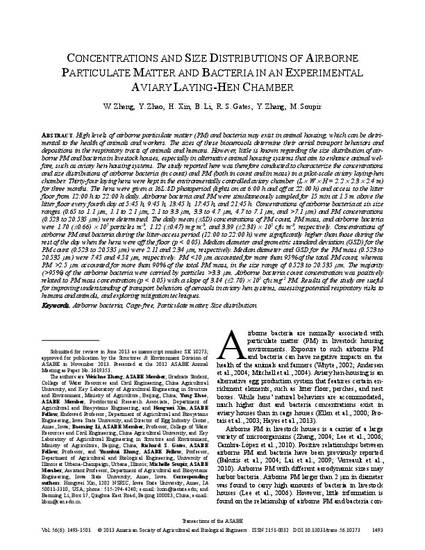
High levels of airborne particulate matter (PM) and bacteria may exist in animal housing, which can be detrimental to the health of animals and workers. The sizes of these bioaerosols determine their aerial transport behaviors and depositions in the respiratory tracts of animals and humans. However, little is known regarding the size distribution of airborne PM and bacteria in livestock houses, especially in alternative animal housing systems that aim to enhance animal welfare, such as aviary hen-housing systems. The study reported here was therefore conducted to characterize the concentrations and size distributions of airborne bacteria (in count) and PM (both in count and in mass) in a pilot-scale aviary laying-hen chamber. Thirty-four laying hens were kept in the environmentally controlled aviary chamber (L × W × H = 2.2 × 2.3 × 2.4 m) for three months. The hens were given a 16L:8D photoperiod (lights on at 6:00 h and off at 22:00 h) and access to the litter floor from 12:00 h to 22:00 h daily. Airborne bacteria and PM were simultaneously sampled for 15 min at 1.5 m above the litter floor every fourth day at 5:45 h, 9:45 h, 13:45 h, 17:45 h, and 21:45 h. Concentrations of airborne bacteria at six size ranges (0.65 to 1.1 µm, 1.1 to 2.1 µm, 2.1 to 3.3 µm, 3.3 to 4.7 µm, 4.7 to 7.1 µm, and >7.1 µm) and PM concentrations (0.523 to 20.535 µm) were determined. The daily mean (±SD) concentrations of PM count, PM mass, and airborne bacteria were 1.70 (±0.66) × 107 particles m-3, 1.12 (±0.47) mg m-3, and 3.39 (±2.38) × 105 cfu m-3, respectively. Concentrations of airborne PM and bacteria during the litter-access period (12:00 to 22:00 h) were significantly higher than those during the rest of the day when the hens were off the floor (p < 0.05). Median diameter and geometric standard deviation (GSD) for the PM count (0.523 to 20.535 µm) were 2.11 and 2.34 µm, respectively. Median diameter and GSD for the PM mass (0.523 to 20.535 µm) were 7.45 and 4.58 µm, respectively. PM <10 µm accounted for more than 95% of the total PM count, whereas PM >2.5 µm accounted for more than 90% of the total PM mass, in the size range of 0.523 to 20.535 µm. The majority (>95%) of the airborne bacteria were carried by particles >3.3 µm. Airborne bacteria count concentration was positively related to PM mass concentration (p < 0.05) with a slope of 3.84 (±2.70) × 105 cfu mg-1 PM. Results of the study are useful for improving understanding of transport behaviors of aerosols in aviary hen systems, assessing potential respiratory risks to humans and animals, and exploring mitigation techniques.
Available at: http://works.bepress.com/richard-gates/42/

This article is from Transactions of the ASABE 56 (2013): 1493–1501, doi:10.13031/trans.56.10273. Posted with permission.